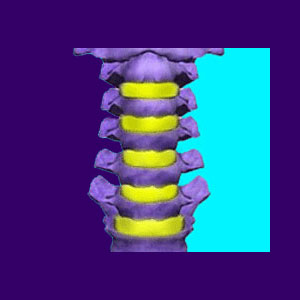
The cervical spine anatomy is extremely interesting and commonly implicated in sourcing a variety of back and neck pain complaints due to structural issues which present themselves due to congenital defect, neck injury or spinal degeneration. The cervical spine represents the top of the spinal column and is commonly called the neck in colloquial terms. The primary purpose of the cervical spine relates to supporting and providing an extensive range of movement for the head.
The anatomy of the neck is delicate and the spinal structures are thinner and lighter than in the rest of the vertebral column. Add to this the diversity and importance of many of the glandular, vascular and neurological structures found here and you have an extremely complex anatomical location which is inherently involved with many vital life functions.
This treatise profiles the neck anatomy and how it might be directly involved in painful expressions and neurological dysfunction.
General Cervical Spine Anatomy
There are 7 cervical bones called vertebrae. These are numbered C1, C2, C3, C4, C5, C6, C7 and are arranged from top to bottom in numerical order. C1 is also named the atlas and C2 is named the axis. These are the 2 vertebrae which are not spaced apart by intervertebral discs in a typical anatomy. C7 is also called the vertebra prominens, since it is indeed rather prominent and can be easily identified through the skin due to the large bump it enacts at the base of the neck.
Besides the first 2 vertebrae, every other cervical bone is spaced from one another by a thin intervertebral disc which acts as both a shock absorber and a facilitator of movement over individual vertebral levels.
Running through the posterior middle of the vertebrae, between the vertebral bodies and the facet joints, is the central spinal canal, which contains the spinal cord and various other crucial tissues. Exiting from each vertebral level are spinal nerve roots which go on to produce the network of nerves throughout the body. These nerves exit both right and left, dorsal and ventral.
Specific Cervical Spine Anatomy
The normal cervical spine demonstrates a noticeable lordotic curvature with the open part of the curve facing the rear of the body. The vertebrae in the neck are small and thin, compared to the bones in the rest of the spine. This holds true for the intervertebral discs, as well.
Injury to these smaller and more delicate structures is certainly possible, particularly when concentrated trauma is directed at the neck. Spinal cord injury in the cervical levels is dire and may even be life threatening in some cases.
It should be noted that since the cervical spine is designed to bend and flex constantly, the incidence of spinal degeneration here is universal. It is normal and expected for humans to exhibit disc desiccation, also known as degenerative disc disease, as well as various forms of spinal osteoarthritis, including facet joint changes in the neck. Most of these conditions are not inherently painful and should not enact symptoms in their mild to moderate forms.
Cervical Spine Overview
The cervical spine is the area which suffers pain more than any other spinal region except the lumbar spine. This may be due to significant structural issues causing neurological effects or may be due to a variety of non-anatomically motivated concerns, such as ischemia.
Patients should never be shocked to find out they have disc degeneration, arthritis or even herniated discs in the neck, particularly in the lower cervical levels, since these conditions are incredibly commonplace.
Patients should also not be surprised to see a loss of cervical curvature in association with any neck pain condition. This is usually due to muscular effects of spasm and not due to any scapegoat structural condition which may be blamed. The loss of lordotic curve in the neck rarely is of any importance to diagnosing or treating a symptomatic expression. However, in some cases, actual anatomical irregularities may prove themselves to be the reason for this change and may require drastic and even surgical treatment.





